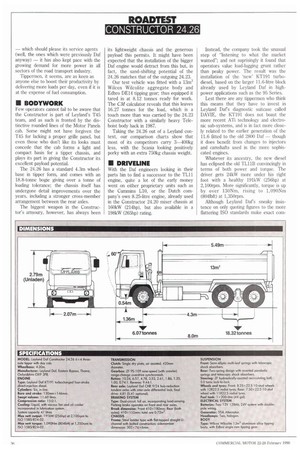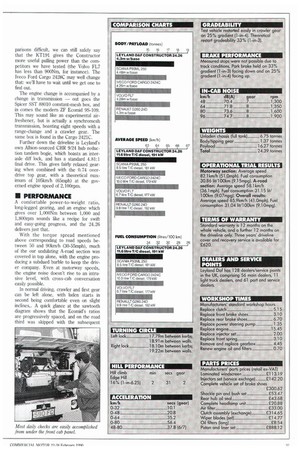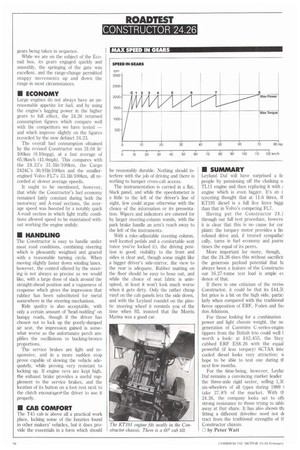• When two parties decide to join together, life is
Page 37

Page 38

Page 39

Page 40

If you've noticed an error in this article please click here to report it so we can fix it.
seldom straightforward. In the same way that marriage is often accompanied by an element of compromise, the merger of two companies normally produces a period of corporate muscle flexing, as each partner seeks to retain its own identity in the new organisation.
Leyland Daf has now been around long enough for most people to get a feeling for the new company's personality, and for how it goes about its business.
What still remains to be seen, however, is how the company's product line will evolve in the long term, for it has been created from two ranges with vastly different philosophies and heredities.
For the time being, rather than cutting models, Leyland Daf is slowly trying to achieve greater commonality of major components within the new range, with some of the first examples being in the Freighter and Constructor chassis, where Daf-derived drivelines have been replacing the original Leyland ones.
Our Constructor 24.26 test vehicle is a good example of this process. Introduced at last year's Tipcon Show, the 24.26 takes over effectively from the 24.21 and 24.23 models with their ageing Leyland TL11 engines.
As its name suggests, the new Constructor gets a hefty increase in power from the engine substitition, for the 11.6litre turbocharged Daf KT191 unit brings with it a decent 191kW (256hp) together with a substantial spread of torque which matches anything in its class.
In this way, Leyland Daf has not only been able to rationalise its engine sourcing which should please its service agents (well, the ones which were previously Daf anyway) it has also kept pace with the growing demand for more power in all sectors of the road transport industry.
Tippertnen, it seems, are as keen as anyone else to boost their productivity by delivering more loads per day, even if it is at the expense of fuel consumption.
• BODYWORK
Few operators cannot fail to be aware that the Constructor is part of Leyland's 145 team, and as such is fronted by the distinctive rounded lines of the Motor Panels cab. Some might not have forgiven the T45 for lacking a proper grille panel, but even those who don't like its looks must concede that the cab forms a light and compact basis for a tipper chassis, and plays its part in giving the Constructor its excellent payload potential.
The 24.26 has a standard 4.3m wheelbase in tipper form, and comes with an 18.8-tonne bogie giving over a tonne of loading tolerance; the chassis itself has undergone detail improvements over the years, including a stronger cross-member arrangement between the rear axles.
The biggest weapon in the Constructor's armoury, however, has always been its lightweight chassis and the generous payload this permits. It might have been expected that the installation of the bigger Daf engine would detract from this but, in fact, the sand-shifting potential of the 24.26 matches that of the outgoing 24.23., Our test vehicle was fitted with a 13m' Wilcox Wilcolite aggregate body and Edbro DE14 tipping gear; thus equipped it tared in at 8.12 tonnes ready for work. The CM calculator reveals that this leaves 16.27 tonnes for the load, which is a touch more than was carried by the 24.23 Constructor with a similarly heavy Telehoist body back in 1987.
Taking the 24.26 out of a Leyland context, our comparison charts show that most of its competitors carry 3 400kg less, with the Scania looking positively porky with an extra 750kg chassis weight.
• DR1VEUNE
With the Daf engineers looking in their parts bin to find a successor to the TL11 engine, quite a lot of the early money went on either proprietary units such as the Cummins L10, or the Dutch company's own 8.25-litre engine, already used in the Constructor 24.20 mixer chassis at 160kW (214hp), but also available in a 198kW (265hp) rating. Instead, the company took the unusual step of "listening to what the market wanted"; and not suprisingly it found that operators value load-lugging grunt rather than peaky power. The result was the installation of the 'new KT191 turbodiesel, based on the larger 11.6-litre block already used by Leyland Daf in highpower applications such as the 95 Series.
Lest there are any tippermen who think this means that they have to invest in Leyland Daf s diagnostic suitcase called DAVIE, the KT191 does not boast the more recent ATi technology and electronic sub-systems, and is in fact more closely related to the earlier generation of the 11.6 fitted to the old 2800 Daf though it does benefit from changes to injectors and camshafts used in the more sophiscated engines.
Whatever its ancestry, the new diesel has eclipsed the old naiB convincingly in terms of both power and torque. The driver gets 24kW more under his right foot with a healthy 191kW (256hp) at 2,100rpm. More significantly, torque is up by over 130Nm, rising to 1,090Nm (8041bft) at 1,350rpm.
Although Leyland Daf's sneaky insistence on only quoting figures to the more flattering ISO standards make exact corn parisons difficult, we can still safely say that the KT191 gives the Constructor more useful pulling power than the competitors we have tested (the Volvo FL7 has less than 900Nm, for instance). The Iveco Ford Cargo 2428C may well change that: we'll have to wait until we get one to find out.
The engine change is accompanied by a change in transmission out goes the Spicer SST 88010 constant-mesh box, and in comes the modern ZF Ecomid 9S-109. This may sound like an experimental airfreshener, but is actually a synchromesh transmission, boasting eight speeds with a range-change and a crawler gear. The same box is found in the Cargo 2421C.
Further down the driveline is Leyland's own Albion-sourced CHR 9/24 hub reduction tandem bogie, which boasts an interaxle diff lock, and has a standard 4.81:1 final drive. This gives fairly relaxed gearing when combined with the 0.74 overdrive top gear, with a theoretical maximum of 105kmth (65mph) at the governed engine speed of 2,100rpm.
• PERFORMANCE
A comfortable power-to-weight ratio, long-legged gearing, and an engine which gives over 1,000Nm between 1,000 and 1,800rpm sounds like a recipe for swift and easy-going progress, and the 24.26 delivers just that.
With the torque spread mentioned above corresponding to road speeds between 50 and 90km/h (30-55mph), much of the our undulating A-road section was covered in top alone, with the engine producing a subdued burble to keep the driver company. Even at motorway speeds, the engine noise doesn't rise to an intrusive level, with cross-cab conversation easily possible.
In normal driving, crawler and first gear can be left alone, with laden starts in second being comfortable even on slight inclines,. A quick glance at the sawtooth diagram shows that the Ecomid's ratios are progressively spaced, and on the road third was skipped with the subsequent gears being taken in sequence.
While we are on the subject of the Ecomid box, its gears engaged quickly and smoothly, the springing of the gate was excellent, and the range-change permitted snappy movements up and down the range in most circumstances.
• ECONOMY
Large engines do nut always have an unreasonable appetite for fuel, and by using the engine's lugging power in the higher gears to full effect, the 24.26 returned consumption figures which compare well with the competitors we have tested — and which improve slightly on the figures recorded by the now defunct 24.23, The overall fuel consumption obtained by the revised Constructor was 31.04 lit/ 100km (9.10mpg), at a fast average of 65.91ma/h (41.0mph). This compares with the 24.23's 31.5lit/100km, the Cargo 2424C's 30.91M/100km and the smallerengined Volvo FL7's 33.1lit/100km, all recorded at slower average speeds.
It ought to be mentioned, however, that while the Constructor's fuel economy remained fairly constant during both the motorway and A-road sections, the average speed was boosted by a notably quick A-road section in which light traffic conditions allowed speed to be maintained without working the engine unduly.
• HANDLING
The Constructor is easy to handle under most road conditions, combining steering which is pleasantly weighted and geared with a reasonable turning circle. When moving slightly faster down winding lanes, however, the control offered by the steering is not always as precise as we would like, with a large dose of slack around the straight-ahead position and a vagueness of response which gives the impression that rubber has been substituted for metal somewhere in the steering mechanism.
Ride quality is also acceptable, with only a certain amount of 'head-nodding' on bumpy roads, though if the driver has chosen not to lock up the poorly-damped air seat, the impression gained is somewhat worse as the unfortunate perch amplifies the oscillations to bucking-bronco proportions.
The service brakes are light and responsive, and in a more sudden stop prove capable of slowing the vehicle adequately, while proving very resistant to locking up. If engine revs are kept high, the exhaust brake provides a useful supplement to the service brakes, and the location of its button on a foot rest next to the clutch encourages s the driver to use it properly.
• CAB COMFORT
The T45 cab is above all a practical work place, lacking some of the luxuries found in other makers' vehicles, but it does provide the essentials in a form which should be reasonably durable. Nothing should interfere with the job of driving and there is nothing to hamper cross-cab access.
The instrumentation is carried in a flat, black panel, and while the speedometer is a little to the left of the driver's line of sight, few could argue otherwise with the choice of the information or its presentation. Wipers and indicators are catered for by larger steering-column wands, with the park brake handle an arm's reach away to the left of the instruments.
With a rake-adjustable steering column, well located pedals and a comfortable seat (once you've locked it), the driving position is good; visibility to the front and sides is clear and, though some might like a bigger driver's side-mirror, the view to the rear is adequate. Rubber matting on the floor should be easy to hose out, and while the choice of seat fabric is uninspired, at least it won't look much worse when it gets dirty. Only the rather cheap vinyl on the cab panels lets the side down, and with the Leyland roundel on the plastic steering wheel it reminds you of the time when BL insisted that the Morris Marina was a good car.
• SUMMARY
Leyland Daf will have surprised a fe people by pensioning off the clanking o TL11 engine and then replacing it with : engine which is even bigger. It's an i Wresting thought that at 11.6 litres, tt KT191 diesel is a full five litres bigg< than that in Volvo's competing FL7.
Having put the Constructor 24.' through our full test procedure, howeve it is clear that this is no cause for cot plaint: the torquey motor provides a fm. relaxed drive and, if treated sympathei catty, turns in fuel economy and journ( times the equal of its peers.
More important for many, though, that the 24.26 does this without sacrificir the generous payload potential that h: always been a feature of the Construct° our 16.27-tonne test load is ample eN dence of that.
If there is one criticism of the revis( Constructor, it could he that its 244,51 list price is a bit on the high side, partici lady when compared with the traditional fierce opposition of ERF, Foden and Se+ don Atkinson.
For those looking for a combination . power and light chassis weight, the ne generation of Cummins C-series-engim tippers from the British trio could well t worth a look: at £42,455, the Stey cabbed ERF ES8.26 with the equal powerful (if less torquey) 6CTAA inte cooled diesel looks very attractive; IA hope to be able to test one during tt next few months.
For the time-being, however, Leylar Daf remains a convincing market leader the three-axle rigid sector, selling 1,11 six-wheelers of all types during 1989 1 take 27.8% of the market. With tb 24.26, the company looks set to off( strong resistance to those trying to nibb. away at that share. It has also shown th; fitting a different driveline need not d( tract from the traditional strengths of 0Constructor chassis.
E by Peter Watt
















































































































































































